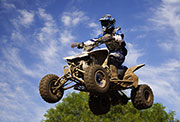
MONDAY, Nov. 24, 2014 (HealthDay News) — Santa might think twice about giving kids an all-terrain vehicle this year. Riding ATVs poses high risks of injury or death for children and teens, with dangers differing by age, a new U.S. study warns.
The biggest risk factors for all ages of children and teens are riding an adult-sized ATV and not wearing a helmet, both of which can have deadly consequences for kids. According to background information in the study, more children in the United States die riding ATVs than riding bicycles each year.
“Despite the warnings, families are still purchasing the increasingly large vehicles and allowing their children to operate them as drivers and ride as passengers even at very young ages,” said Dr. Mary Aitken, a professor of pediatrics and public health at the University of Arkansas for Medical Sciences.
“Finding a more effective way to communicate the risks of these vehicles to parents and youth is key,” said Aitken, who was not involved with the study. “But in the meantime, a combination of strategies including training exposure, improving vehicle design to improve safety and improving enforcement of existing policies may help.”
For the study, researchers analyzed all deaths involving ATVs that were reported to the U.S. Consumer Product Safety Commission between 1985 and 2009. The findings were published online Nov. 24 in the journal Pediatrics.
The study found children’s deaths on ATVs accelerated between 2001 and 2004. This is likely due to more unsafe riding on roads using heavier and faster ATVs, said lead researcher Gerene Denning, director of emergency medicine research at the University of Iowa Carver College of Medicine in Iowa City.
She said they identified the four top reasons — all preventable — that children and teens are killed or seriously injured on ATVs: riding adult-sized vehicles; riding on roads; carrying or riding as a passenger; and not wearing a helmet.
The single biggest risk factor, children riding adult-sized ATVs, was involved in 95 percent of all deaths during the time period studied.
“No matter how exceptional you believe your child or teen to be, minors do not have the cognitive or physical maturity to operate adult ATVs,” Denning said. “Every parent should imagine their child losing control, rolling over and being crushed by a vehicle weighing hundreds and hundreds of pounds. That is a growing reality.”
Children’s smaller body mass makes it harder to balance the vehicle through weight shifting, and their hands may be too small to fully grip the steering and operate the brakes, Denning said.
Shorter arms and legs also mean less ability to turn the vehicle or absorb shocks as well, Denning said. “Kids can be launched off the ATV when hitting a bump or rut,” she said.
Further, riding ATVs requires strong concentration, decision-making skills, mature behavior and an understanding of safe riding that children usually lack, much as they lack the mental maturity to drive a car, Denning said. “Mile for mile, ATVs are thousands of times more dangerous than automobiles,” she said.
More than 60 percent of the ATV-related deaths occurred while children or teens were riding on roads, which the vehicles are not designed to do. Adolescents comprised the largest proportion of road-related ATV deaths.
Passenger riding was the biggest age-specific risk factor for the youngest children. Among children under 6 years old, 75 percent of deaths involved riding as a passenger on ATVs, usually operated by adults.
“Parents and grandparents giving children a ride need to realize they are putting their loved one at significant risk for injury,” Denning said. “Even going at low speeds, crashes have happened.”
Finally, Denning said more than half of all ATV-related injuries and deaths involved head injuries. Wearing a helmet could reduce fatal injuries by half and non-fatal head injuries by 80 percent, she said.
According to Aitken, the tremendous variability in state laws and enforcement of those laws makes it difficult to assess how effective ATV regulations are.
“Some studies have shown that states with helmet and other laws have improved safety behaviors or that death rates may be lower in states that have some policies restricting use,” she said.
There has been corporate and legal resistance to improving ATV safety, Denning said.
“Overall, there has never been a safety culture around ATVs,” Denning said. “Most people perceive them as safer than they are and don’t understand the factors that make them so dangerous. This includes parents.”
Engineering improvements in safety, such as shorter seats and requirements to meet stability and crashworthiness standards, would help prevent injuries, she said.
“We will make very little progress until we have more evidence-based, well-enforced ATV safety laws in every state,” Denning said. “Laws define what is responsible and most people wanting to be seen as responsible obey the laws.”
More information
The Consumer Product Safety Commission has more about ATV safety.
Copyright © 2025 HealthDay. All rights reserved.

